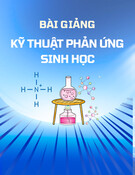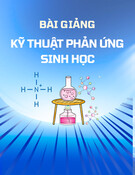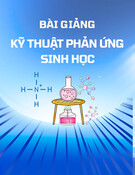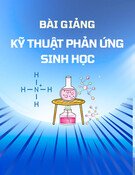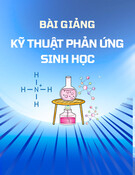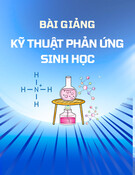
HPU2. Nat. Sci. Tech. Vol 02, issue 01 (2023), 70-75
HPU2 Journal of Sciences:
Natural Sciences and Technology
journal homepage: https://sj.hpu2.edu.vn
Article type: Research article
Received date: 27-4-2023 ; Revised date: 28-4-2023 ; Accepted date: 28-4-2023
This is licensed under the CC BY-NC-ND 4.0
Synthesis of new 1,2,4-triazine derivatives
bearing the benzofuran moiety
Que-Ngan Bui Thi
a
, Thuy-Trang Nguyen Thien
a
, Thu-Nghia Nguyen Thi
a
, Tan-Tai Nguyen
a,*
a
Faculty of Chemistry, University of Science, Vietnam National University Ho Chi Minh City, Vietnam
Abstract
In the aim of further research of the highly bioactive benzofuran and triazine derivatives, the
synthesis of 1,2,4-triazine derivatives bearing the benzofuran moiety has been undertaken.
Using a simple and convenient method, a three steps synthesis of novel functionalized 1,2,4-
triazine derivatives from readily available starting materials has been described. Herein, two
derivatives of 1,2,4-triazine were obtained in moderate yields. The structures of all
synthesized compounds were elucidated by spectral methods of analysis
Keywords: Benzofuran, 1,2,4-triazine hybrid molecule
.
1. Introduction
In recent years, hybrid molecules, the combination of two or more active agents in a single
molecule, have been widely studied by many pharmaceutical research groups. Multiple projects have
aimed to design and synthesis these compounds and the results are very encouraging. These hybrid
molecules exhibit strongly biological potential such as anticancer, antituberculosis, anti-inflammatory,
antibacterial, antifungal and antimalarial.
1
Benzofuran moiety is widely occurred in natural compounds and has become attractive to
researchers because of their biological activities including antifungal, antibacterial, antiviral,
anticancer and anti-HIV activities.
2-4
In addition, 1,2,4-triazine derivatives have wide spectrum of
biological activities, as diverse as antibacterial, antifungal, anti-inflammatory, antidepressant, antiviral,
anticancer…
5
Synthesis and structural modification of 1,2,4-triazine to be able to explore different
* Corresponding author, E-mail: nttai@hcmus.edu.vn
https://doi.org/10.56764/hpu2.jos.2023.1.2.70-75

HPU2. Nat. Sci. Tech. 2023, 2(1), 70-75
https://sj.hpu2.edu.vn 71
biological activities has now become an important goal of several research groups. However, due to
the ability to create many different derivatives or combine with other frameworks, the research
direction on synthesizing 1,2,4-triazine derivatives is still very promising and developing widely.
Therefore, the goal of this research is to prepare some novel hybrid molecules of 1,2,4-triazine
derivatives bearing the benzofuran moiety. In the present study, the three steps synthesis starting from
salicylaldehyde was achieved.
2. Materials and methods
2.1. General
All chemicals were purchased from Merck (for synthetic class) and Sigma Aldrich while organic
solvents were purchased from the commercial source and were used without any further purification.
The NMR spectra were acquired using the Bruker Avance III spectrometer (500 MHz for 1H and 125
MHz for 13C). Chemical shifts are expressed in parts per million (ppm) and reported relative to the
residual solvent signal as an internal reference. High resolution mass spectra (HRMS) were recorded
using a HRMS X500R QTOF mass spectrometer in electrospray ionization (ESI) mode. The melting
points were determined using a Gallenkamp digital Melting point apparatus 5A-6797 with a rate of
heating of 2°C/min. Reactions were monitored using thin layer chromatography (TLC) on silica gel
plates (silica gel 60 F254, Merck), visualized under ultraviolet light (254 nm). Column chromatography
was performed on silica gel Merck 60 (230–400 mesh) purchased from HiMedia Laboratories Pvt.
Ltd. (India).
2.2. Synthesis of ethyl benzofuran-2-carboxylate (1)
A solution of salicylaldehyde (18.30 g, 0.15 mol) and potassium carbonate (62.10 g, 0.45 mol) in
DMF (150 mL) was stirred at room temperature for 30 minutes. Then, ethyl chloroacetate (18.38 g,
0.15 mol) was slowly dropped into that solution while the mixture was stirred during two hours at
8090 °C. The color of solution was changed from yellow to green, dark green, brown and finally
black. Consequently, that solution was poured into crushed ice and was extracted with ethyl acetate
(100 mL 3). Then, the combined organic phases were dried over anhydrous sodium sulfate and
evaporated under reduced pressure to afford ethyl benzofuran-2-carboxylate (1) (21.9 g, 77%).
Dark yellow liquid; 1H–NMR (500 MHz, DMSO-d6):
H (ppm): 7.75 (dd, J = 7.9 Hz, 1.2, 1H),
7.67 (dd, J = 8.4, 1.2 Hz, 1H), 7.65 (s, 1H), 7.47 (ddd, J = 8.4, 7.3, 1.2 Hz, 1H), 7.31(ddd, J = 7.9,
7.3, 1.2 Hz, 1H), 4.32 (q, J = 7.0 Hz, 2H), 1.30 (t, J = 7.0 Hz, 3H); 13C–NMR (125 MHz, DMSO-d6):
C (ppm): 158.6, 155.0, 145.1, 127.7, 126.6, 123.8, 123.0, 113.8, 112.0, 61.1, 13.9. These data are
consistent with that reported in the literature.6
2.3. Synthesis of benzofuran-2-carbohydrazide (2)
A solution of ethyl benzofuran-2-carboxylate (1) (11.40 g, 0.06 mol) in absolute ethanol (30 mL)
was slowly continuously added by hydrazine hydrate 50% (18.00 g, 0.18 mol) under reflux for four
hours. Upon completion, the reaction mixture was kept at 24 °C overnight to solidify the product.
Consequently, the separated solid was filtered, washed with cold ethanol and then recrystallized in
absolute ethanol to give benzofuran-2-carbohydrazide (2) (8.46 g, 80%).
White crystals, melting point 190194 °C (lit. 6 190194 °C); 1H–NMR (500 MHz, DMSO-d6):
H (ppm): 10.02 (s, 1H), 7.76 (dd, J = 8.0, 0.8 Hz, 1H), 7.63 (dd, J = 8.4, 0.8 Hz, 1H), 7.51 (s, 1H),
7.44 (ddd, J = 8.4, 7.3, 0.8 Hz, 1H), 7.32 (ddd, J = 8.0, 7.3, 0.8 Hz, 1H), 4.58 (br, 2H); 13C–NMR

HPU2. Nat. Sci. Tech. 2023, 2(1), 70-75
https://sj.hpu2.edu.vn 72
(125 MHz, DMSO-d6):
C (ppm): 157.8, 154.1, 148.4, 127.0, 126.6, 123.6, 122.6, 111.7, 108.7. These
data are consistent with that reported in the literature.6
2.4. General procedure for the synthesis of phenacyl bromide compounds (3)
A solution of acetophenone derivative (10 mmol) in chloroform (10 mL) at 0 °C was added by
few drops of H2SO4. Then, a cold chloroform solution of bromine (1.6 g, 10 mmol) was dropwise
added. That system was kept stirring at the same temperature for half an hour and then at room
temperature for another hour. Consequently, a solution Na2S2O3 10% (20 mL) was added to the
mixture. The aqueous phase was extracted with chloroform (20 mL 3). All organic phases were
collected, dried over Na2SO4 and concentrated under reduced pressure. The obtained crude product
was purified by recrystallization in EtOH to give the corresponding product.
2-bromo-1-phenylethan-1-one (3a): 1.78 g, yield: 90%, white needle crystals; 1H-NMR (500
MHz, CHCl3) δH (ppm): 7.99 (dd, J = 8.3, 1.4 Hz, 2H), 7.61 (td, J = 7.3, 1.4 Hz, 1H), 7.52 – 7.47 (m,
2H), 4.46 (s, 2H); 13C-NMR (125 MHz, CDCl3) δC (ppm): 191.4, 134.1, 133.9, 129.1, 129.0, 31.1,
31.0.
2-bromo-1-(4-chlorophenyl)ethan-1-one (3b): 1.98 g, yield: 85%, white needle crystals; 1H-NMR
(500 MHz, CHCl3) δH (ppm): 7.93 (d, J = 8.6 Hz, 2H), 7.47 (d, J = 8.6 Hz, 2H), 4.41 (s, 2H); 13C-
NMR (125 MHz, CDCl3) δC (ppm): 190.4, 140.7, 132.4, 130.5, 129.4, 30.5.
2.5. General procedure for the synthesis of 3-(benzofuran-2-yl)-6-aryl-1,2,4-triazine (4)
Dissolve benzofuran-2-carbohydrazide (2) (0.2 g, 1 mmol), sodium acetate (0.07 g, 0.8 mmol)
and phenacyl bromide (3) (0.1 g, 0.5 mmol) in 10 mL of EtOH/CH3COOH (v/v 3:1) and heat under
reflux for for 12 hours. Then the reaction solution was cooled to room temperature. The solid obtained
was filtered and washed with EtOH to obtain a yellow solid.
3-(benzofuran-2-yl)-6-phenyl-1,2,4-triazine (4a): 150 mg, yield: 55%, yellow needle crystals; 1H-
NMR (500 MHz, CHCl3) δH (ppm): 9.07 (s, 1H), 8.20 – 8.14 (m, 2H), 7.94 (d, J = 1.0 Hz, 1H), 7.75
(dd, J = 7.8, 1.0 Hz, 1H), 7.69 (dd, J = 8.3, 0.9 Hz, 1H), 7.63 – 7.54 (m, 3H), 7.45 (ddd, J = 8.4, 7.2,
1.3 Hz, 1H), 7.34 (ddd, J = 8.0, 7.2, 0.9 Hz, 1H); 13C-NMR (125 MHz, CDCl3) δH (ppm):157.0, 156.5,
155.2, 151.1, 146.5, 133.2, 131.3, 129.6, 128.3, 127.1, 126.9, 123.9, 122.6, 112.4, 111.3; HR-MS
(TOF) calcd. for C17H11ON3 [M+H]+: 274.0975, found: 274.0962.
3-(benzofuran-2-yl)-6-(4-chlorophenyl)-1,2,4-triazine (4b): 199 mg, yield: 65%; yellow powder;
1H-NMR (500 MHz, CHCl3) δH (ppm): 9.05 (s, 1H), 8.12 (d, J = 8.6 Hz, 2H), 7.94 (s, 1H), 7.75 (d, J =
7.8 Hz, 1H), 7.69 (d, J = 8.3 Hz, 1H), 7.57 (d, J = 8.5 Hz, 2H), 7.45 (ddd, J = 8.5, 7.2, 1.3 Hz, 1H),
7.34 (dd, J = 7.8, 7.2 Hz, 1H); 13C- NMR (125 MHz, CDCl3) δH (ppm): 157.4, 156.8, 154.4, 151.2,
146.4, 138.1, 131.8, 130.2, 128.5, 128.4, 127.5, 124.2, 122.9, 112.7, 111.8; HR-MS (TOF) calcd. for
C17H10ON335Cl [M+H]+: 308.0585, found: 308.0572.
Benzofuan-2-carboxamide (4’): 1H-NMR (500 MHz, CHCl3) δH (ppm): 9.32 (s, 1H), 8.86 (s, 1H),
7.67 (d, J = 7.8 Hz, 1H), 7.52 (m, 2H), 7.45 (t, J = 7.5 Hz, 1H), 7.31 (t, J = 7.5 Hz, 1H); 13C- NMR
(125 MHz, CDCl3) δH (ppm): 167.2, 155.0, 146.2, 127.6, 127.1, 124.0, 122.8, 112.2, 112.0.
3. Results and discussion
The 1,2,4-triazine (4a, 4b) derivatives were synthesized according to Scheme 1. Salicylaldehyde
reacts with ethyl chloroacetate formed ethyl benzofuran-2-carboxylate (1), which was subsequently
treated with hydrazine hydrate to afford benzofuran-2-carbohydrazide (2), with the yields of 77% and
80%, respectively. On the other hand, we prepared phenacyl bromide derivatives 3a and 3b by the

HPU2. Nat. Sci. Tech. 2023, 2(1), 70-75
https://sj.hpu2.edu.vn 73
bromination of corresponding acetophenone compounds with the yields ranging from good to
excellent.
Scheme 1. The synthetic route for the preparation of 1,2,4-triazine derivatives
The key step of this protocol is cyclization between benzofuran-2-carbohydrazide (2) and
phenacyl bromide (3). We obtained two derivatives with moderate yields. The chemical structures of
these products were elucidated using the 1H and 13C NMR spectra. The presence of singlet signal of
proton N–CH=C at about 9.0-9.1 ppm and the disappearance of proton CH2Br at 4.4 ppm in the 1H–
NMR spectrum of each derivative allowed us to confirm the successful cyclization. Furthermore, in
the 13C-NMR spectra, the disappearance of carbon CH2Br at the high field signal about 30 ppm and of
carbon C=O at about 190 ppm were further supportive of this structure.
A possible reaction mechanism for the formation of triazine has been proposed as shown in
Scheme 2. First, the amino group of carbohydrazide attacks alpha carbon carbonyl by the SN2
reaction. Then, the amino group of another carbohydrazide attacks the carbonyl group, followed by the
dehydration to form imine compound. The cyclization reaction occurs between the amino group of the
first carbohydrazide and carbonyl group of the second carbohydrazide, followed by dehydration and
the leaving of benzofuan-2-carboxamide to form 1,2,4-triazine derivatives. We also isolated the
benzofuan-2-carboxamide (4’), a by-product of this reaction. Its presence is evidence supporting the
relevance of this mechanism.

HPU2. Nat. Sci. Tech. 2023, 2(1), 70-75
https://sj.hpu2.edu.vn 74
Scheme 2. Proposed reaction mechanism of the formation of 1,2,4-triazine derivatives.
The obtained results can be explained by the effect of the substituent on the aromatic ring of
phenacyl bromide. The mild electron withdrawing substituent (–Cl) which attract electrons to the
aromatic ring can activate the carbonyl of phenacyl bromide. That leads to the formation of product 4b
with a higher yield (65%) compare to that of product 4a (55%) in the absence of the substituent
(R=H).
4. Conclusions
A facile, convenient and good yielding synthesis of novel 1,2,4-triazine derivatives bearing the
benzofuran moiety from readily available starting materials has been described. Starting from
salicylaldehyde, we have synthesized two 1,2,4-triazine derivatives in three steps. The product of the
first step is ethyl benzofuran-2-carboxylate (1) with the yield of 77%. Then, the product (1) is
converted to benzofuran-2-carbohydrazide (2) with the yield of 80%. The products of the third step are
1,2,4-triazine derivatives, namely, 3-(benzofuran-2-yl)-6-phenyl-1,2,4-triazine (4a) and 3-
(benzofuran-2-yl)-6-(4-chlorophenyl)-1,2,4-triazine (4b) with the yields of 55% and 65%,
respectively. As a result, the substituent on the aromatic ring showed an effect in the cyclization step.
In fact, the substrate bearing a mild electron withdrawing group (–Cl) as substituent on the aromatic
ring can lead to cyclization with a better yield. Their chemical structures were elucidated through
NMR and HR–MS spectral analysis. All triazine derivatives are new compounds, reported for the first
O
O
NHNH2
+
Br
O
O
O
NHNH
O
O
O
H2NHN
O
O
NHNH
O
NH
NH
OO
H
O
O
NHNH
HO
HN
NH
OO
O
O
NHNH
N
NH
O
O
ON
NHN
NH
H
O
OO
ON
NHN
NH
HO
OO
ON
NHN
HN
O
O
ON
NN
HN
O
O
HON
NN
+
O
O
H2N


![Tổng hợp cấu trúc lai giáp cạnh 5H-thiazolo[2′,3′:2,3]imidazo[4,5-b]indole bằng phản ứng ghép cặp C-N liên tiếp xúc tác đồng](https://cdn.tailieu.vn/images/document/thumbnail/2025/20250330/vimitsuki/135x160/2451743340007.jpg)


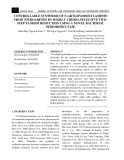
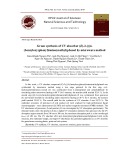
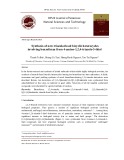
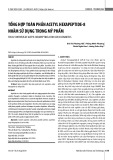

![Nghiên cứu tổng hợp dẫn xuất thế thieno[3,2-b]thiophen bằng phản ứng xúc tác palađi](https://cdn.tailieu.vn/images/document/thumbnail/2024/20240929/xuanphongdacy09/135x160/8461727545047.jpg)



![Bài tập Đa dạng thế giới sống [kèm đáp án/ hướng dẫn giải]](https://cdn.tailieu.vn/images/document/thumbnail/2025/20251123/thaohoang9203@gmail.com/135x160/5861763951302.jpg)
